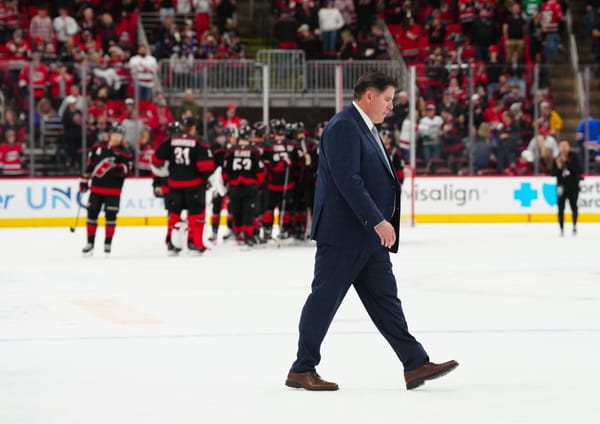The J.T. Miller Question
The most important season of Miller’s career is underway and he could be playing his way into a big payday.
J.T. Miller will be 25-years-old when the 2017-18 season expires. He’ll also be a restricted free agent.
What Miller’s next contract looks like is a question that’s been hanging over the team since Jeff Gorton chose to sign him to a two-year bridge deal after his one-year post-ELC deal expired. That decision by Gorton could cost the team a lot of money moving forward.
To be fair to Gorton signing Miller to a long-term deal after the 2015-16 season wasn’t exactly a no-brainer. He had a 22-goal season, but that had a lot to do with shooting 16.5 percent. It’s also important to remember that the Rangers were in the first year of Derek Stepan’s massive contract extension that year and that Miller was sixth on the team in points per game.
We might as well jump right into some numbers because when we discuss Miller’s value to the team you can’t avoid celebrating his even strength numbers.
Since Miller’s first full NHL season he’s been one of the Rangers most productive players. Over the past three seasons the only Ranger who has more points than Miller is Mats Zuccarello. What’s even more impressive than that is the fact that only 15 of Miller’s 118 points since the 2015-16 season have come on the power play. Despite Miller seeing far less ice time than his diminutive Norwegian teammate, he has just two fewer points than Zuccarello at even strength in the last three seasons.
If we turn our focus specifically to 5-on-5 play, Miller finished third on the team in 5-on-5 points in 2015-16 and 2016-17. So, where is he this year? You guessed it, third on the team (tied with David Desharnais). How about where he ranked in total 5-on-5 ice time? Yep. Third in all three seasons.
So, third on the Rangers in 5-on-5 scoring and total 5-on-5 ice time for going on three years now? That sounds a lot like a guy you would call a key forward. But even with a significant increase in power play ice time this season, Miller is still sixth among Rangers forwards in average time on the man advantage. He’s been stuck on the second PP unit.
Miller, at least in my opinion, is something of a chimera. However, there’s no denying that he’s a gifted passer and that he knows how to create goals. But even last year when he finished second on the team in points (behind Zuccarello), Alain Vigneault didn’t use Miller like a prized forward. In 2016-17 Miller ranked sixth among Rangers forwards in average even strength TOI/GP. And keep in mind that Mika Zibanejad played just 56 games last year and that Miller was demoted to the fourth line in the playoffs.
The Zibanejad injury this season has pushed Miller back into the role of center; a role he failed to land out of training camp. He’s been great on the dot (54.3%), but his possession numbers still leave a lot to be desired. Miller is one of the worst Rangers forwards in adjusted Relative CF% (-1.73) this season, but the points are there like they have been the past two seasons. During 5-on-5 play Miller’s in the red in SCF% (47.16) and SF% (45.07), but in the green in GF% (52.94) – so again, the points are there.
Something else to keep in mind here is that before Lias Andersson came off the board in the 2017 draft, Miller (#15 overall) was the Rangers highest-drafted forward in recent history. Before him, it was Hugh Jessiman in 2003. That will carry at least some weight in contract negotiations, especially with Derek Stepan playing hockey in the desert. It’s also important to note that Miller hasn’t missed a game since the beginning of the 2015-16 season.
So, what the hell do you pay this guy?
Ideally the Rangers will find a way to fit him below the cap hits of Chris Kreider and Zuccarello, or at least have his AAV land in a similar neighborhood. If Miller stays on this scoring pace and remains healthy he could finish in the neighborhood of 59 points. That would mean 191 points in his first 360 NHL games. Let’s plug that into capfriendly.com and take a look at what players in similar situations to Miller have made in recent years.
If Miller continues his scoring pace, the Rangers will have a hard time keeping him from making $5 million a season in his next contract. It will be even harder to keep Miller away from that AAV if he continues to play center. The good news is that the salary cap is projected to increase and that Rick Nash’s $7.8 million cap hit is coming off of the books. The bad news is that Miller is somewhat one-dimensional and one could argue that he hasn’t been used in a “featured role” yet despite being 24-years-old going on 25.
Of course, it isn’t just Miller who has this big and likely expensive question mark hanging around him this season. Kevin Hayes is also a pending RFA. And, like Miller, he is going to get paid.
In many ways the Zibanejad injury has made the expiring contracts of Miller and Hayes an even bigger storyline. Without the Swedish center in the lineup, both Miller and Hayes are playing bigger roles for the Rangers. Those bigger roles mean opportunities to prove to the Rangers front office that they are players worth substantial investments like the one Gorton made in Zibanejad before this season.
Data courtesy Hockeyviz.com, Corsica.hockey, naturalstattrick.com, NHL.com, capfriendly.com




